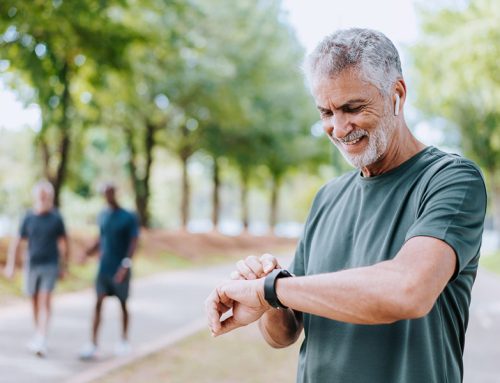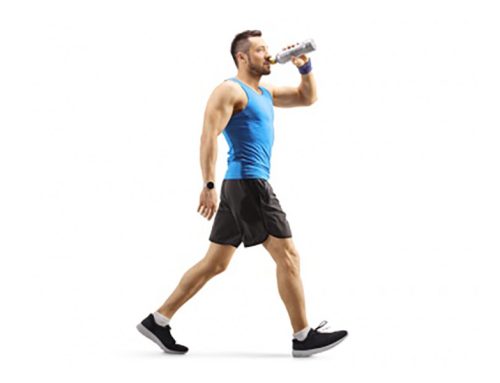Is it mandatory to do cardio in addition to weights? Can’t you just eat right and lift? If cardio is mandatory, what is the best way to integrate cardio and weights? How much, what type, how hard, and when? And at what point is it too much cardio? The answer to these questions may depend on your goals, preferences, and time available. It also depends on the kind of shape you’re in now. Some people need to start with easy exercise like walking and build up to more intense types of cardio gradually. Others are well-conditioned enough to blast it with high intensity cardio.
Regardless of your goals, preferences, time available or current fitness, the answer to the question, “Should you always be doing weights and cardio” is YES, absolutely. Everyone should doing cardiovascular (aerobic) exercise for health reasons alone. But I suppose the real answer could depend on what your definition of “cardio” is. Do you count walking as cardio?

Why Everyone Should Do Cardio In Addition To Weights
I know some really lean and muscular bodybuilders who do a lot of weight lifting and they claim, “I don’t do any cardio.” However, they do a lot of walking. What they really meant is that they don’t run, use cardio machines or take cardio classes, and they aren’t counting walking as cardio.
Every exercise program should include weights and some kind of cardio because both types of exercise have distinct benefits. And when I say everyone should do cardio in addition to weight training, I am counting walking as one of the many types of cardio you could choose from.
Your health should be a major reason you include cardio. Of course, cardio also helps with fat loss. Keeping up a high daily physical activity level is even more important for maintaining fat loss. People who lose weight but then are sedentary usually gain it back.
Always remember though, that for cutting body fat in the first place, controlling your diet is the number one priority. Cardio simply helps the fat loss along a little bit more when added on top of a well-controlled diet. It’s best not to think of cardio as the main driver of fat loss, but more like a booster.
If you don’t control your diet (specifically, to be sure you have a calorie deficit), you wont lose fat even if you’re doing cardio like an endurance athlete. In fact, many runners don’t lose any weight despite burning a huge number of calories because they eat all those calories right back. Even a huge amount of cardio doesn’t guarantee fat loss. Only a calorie deficit ensures fat loss.
“You can’t out train a bad diet” – what this really means
Clearing Up The Definition Of “Cardio”
One reason a lot of people get confused about how much and what kind of cardio to do is because a person’s definition of terms like cardio, exercise or physical activity may vary. In addition, when talking about cardio, intensity often doesn’t get specified. It’s hard to make good cardio recommendations without talking about the intensity.
Usually when most people think about the definition of “cardio” they’re thinking about activities like getting on a cardio machine – elliptical, stairclimber, stationary bike, treadmill and so on. Doing “cardio” may also refer to taking a boot camp or aerobics class, doing interval training, swimming, running and so on.
These are intentional or formal exercise sessions that are somewhat intense and really get the breathing and heart rate up. But walking is certainly cardio as well, and a great form of it. Light walking may not be intense compared to other types of exercise, but intentional bouts of walking can qualify as low to moderate intensity cardio. (Walking briskly on an inclined treadmill can reach intensities comparable to jogging but without the impact).
The main thing to remember is that if you choose low to moderate intensity cardio activities like walking, it will take a lot more of it to match the benefits of higher intensity cardio. Conversely, if your cardio is higher in intensity, you can do less of it and still get the same benefits.
When it comes to fat loss, the most recent research comparing high intensity cardio to low intensity cardio found that neither one was superior. You can lose the same amount of fat doing low or moderate intensity cardio as high intensity cardio. The difference is, when cardio intensity is lower, you burn fewer calories per minute, so it takes a lot longer to achieve the same fat loss. For example, you might need 60 minutes of brisk walking to get the the same calorie burn and subsequent fat loss as 30 minutes of moderately-high to high intensity cardio.
How Much Cardio? Prescribing In Minutes Or Steps
Virtually every public health and exercise organization in the world says we should aim for at least 150 minutes of moderate exercise or activity per week. They also say 200 to 210 minutes is even better to ensure good health. “Moderate” exercise is defined as an intensity at least equal to brisk walking.
150 minutes of exercise per week is 5 days a week for 30 minutes per session, or 4 days a week and just under 40 minutes per session. This is a realistic prescription for how much cardio exercise to aim for and its always important to remind yourself that you’re doing it for health, not just for fat loss.
Prescribing cardiovascular exercise in minutes is standard for health organizations, but you can also use daily step counts (Fitbit or other fitness tracker) to see how much total physical activity you’re getting.
Tracking daily steps is really helpful because it gives you an idea of how physically active you are outside of the formal cardio sessions you do. Your total daily step count includes all your daily activity, and when it comes to both health and fat loss, all your daily activity matters, not just formal “cardio” sessions.
Some people do official cardio sessions 5 days a week for 30 minutes per bout. That meets health guidelines and seems like a substantial amount. But they’re astonishingly sedentary the whole rest of the day, so they’re actually not as physically active as they think.
A term was coined for this: “Active couch potatoes.” That’s people who do formal workouts, but outside those workouts, they don’t move much. Paradoxically, these types of people might find themselves losing fat more slowly compared to someone who goes to the gym less but is highly active overall, walks a lot and has a high daily step count.
Some people rack up thousands of extra steps a day outside of formal exercise sessions because they have physically active jobs, they walk dogs, or do a lot of work around the house. Others are virtually sedentary.
10,000 steps a day is a great goal (“very active”), but even 7,000 to 8,000 steps a day is very good (“active”). People who are under 5,000 steps a day are inactive and should really strive to increase their step count for both health and fat loss reasons.
Something to think about is that if you have a really high daily step count from miscellaneous activity and walking, you won’t need as many formal cardio sessions.
Here’s a case study: I know a bodybuilder who does no formal “cardio” at all, but he walks a lot and is so physically active, he averages 14,000 steps a day (thats “extremely active”). He got all the way to competition condition with ripped abs simply by focusing on his diet, his lifting and his step count, and his steps were spread out through the day in lots of little activity bouts not just one long hard cardio session.
It blows people’s minds (or makes them mad / jealous) when he tells them (brags), “I do zero cardio.” But the fact is, he actually does a lot of daily exercise, his “cardio” is simply walking, he picks up a lot of incidental steps all day long, and of course he does a ton of lifting too. (He even walks around the gym floor between sets instead of sitting down).
Yes, Walking Counts As Cardio: So Just Walk, Or Choose The Cardio Of Your Preference
Remember that the general health recommendation of “moderate exercise” includes brisk walking. A lot of people who do our Burn the Fat, Feed the Muscle program or follow Burn the Fat Inner circle weight training programs Like 2/3 Hybrid MASS, 3-Day Classic Muscle or TNB-28, simply walk briskly and call that their cardio. Walking is low impact, easy to do and incredibly good for your health.
The health recommendations for exercise don’t necessarily mean doing intense cardio like high-intensity interval training (HIIT) or running or a hard class or hard workout on cardio machine.
The 150 minutes of exercise a week health guideline could include only moderate cardio like brisk walking, it could include more intense cardio, or it could be a combination of both light-moderate and intense cardio. (It doesn’t have to be the same type or intensity of cardio every day of the week).
Benefits Of Intense Cardio
If you want to make some of your weekly cardio sessions more intense and get your heart rate and breathing up, that’s great.
More intense cardio gives you even greater fitness benefits. You burn more calories per minute too, so harder cardio workouts can help with more efficient, faster fat loss. Walking, even briskly, doesn’t burn that many calories compared to more intense cardio sessions, so while walking is fantastic for health, it does take a whole lot of it to really impact fat loss.
Yet another benefit of intense types of cardio like HIIT is time efficiency.
A lot of people have genuinely busy lives including full time work along with family obligations. People with fat loss goals who are busy and don’t have a lot of time to exercise will be forced to depend more on the diet side of the energy balance equation to achieve their calorie deficit because with their schedules, it’s not practical to keep adding more and longer cardio sessions or walk for hours.
But busy people can always make the best use of the limited time they have by using time efficient weight training programs like TNB-TURBO (with supersets) and by doing intense cardio. Intense cardio burns more calories in the same time and it can produce much greater health benefits in a remarkably short time.
It’s fine to make all your cardio something slow and easy like walking, but if you are already fit and you want to get the highest calorie burn and most benefit possible, you might want to do all of your cardio sessions (4 to 5 times a week, etc) at a moderately high to high intensity.
Another option is to do a mix of some easier exercise (walking) and some harder cardio. Something like a long brisk walk 3 times a week and briefer but harder cardio sessions 2 or 3 times a week is a sensible and sustainable approach.
How Much Weekly Cardio For Fat Loss Goals?
Most people with fat loss goals, in addition to their lifting program, do at least 3 to 4 days a week of formal cardio, usually 30 to 60 minutes at a moderate to moderately hard intensity (enough to get heart rate and breathing up).
If there are no time constraints, fat loss seekers can increase the cardio frequency to 5, 6, or 7 days a week if they want / need to increase the rate of fat loss. Time can be increased as well from 30 to 40 to 50 or 60 minutes if a boost to fat loss needed. Rather than thinking more is always better, it’s ideal to start with a moderate and practical amount of cardio, and only add more cardio later (progressively) if fat loss slows down or plateaus. This way extra cardio is like an ace in the hole and you don’t burn out early.
The duration of your cardio sessions doesn’t always have to be the same every time either. I know a lot of people who make it a point to do a long hike every weekend which might be 90 minutes, 2 hours or even longer. That gives the weekly total a nice bump.
What Is The Best Time To Do Your Cardio?
A lot of people ask, “When is the best time to do cardio?” For your health and your fat loss, the time of day you do cardio does not matter. The best time to do cardio is when it’s convenient for you and when you’re most likely to get it done and stick with it consistently.
One general rule that’s good to follow is that if building muscle and strength are important priorities for you, it’s best not to do cardio right before weights in the same session. Doing cardio first will interfere with lifting performance.
Many people do however perform cardio after weights in the same session. This is especially common for people who commute to a gym to use the weights and cardio machines. It would be an inconvenience to go back to the gym twice in one day, (more driving, and also more laundry and showers), so they get their resistance training and cardio training done back to back in one visit.
When it’s feasible to separate weights and cardio (morning and night for example) that is even better when the goal is building muscle size and strength. This may or may not involve two trips to the gym in one day. When you have fitness equipment at home, twice a day workouts (cardio and weights done separately) are more convenient. Plus for many people their cardio is walking, hiking or running, so they don’t need a gym for cardio, or they have a cardio machine at home.
When someone’s primary goal is building muscle size and strength (not fat loss), it’s ideal to keep intense cardio to a minimum, like only 2 or 3 sessions per week. Too much high intensity cardio can interfere with muscle and strength gains. Any additional cardio should be low or moderate in intensity (like walking or easy cycling). You should still aim to meet weekly physical activity or step count goals for health.
What Is The Best Type Of Cardio?
Last but not least, the type of cardio you choose doesn’t matter much either. Any kind of cardio can help with fat loss and give you health benefits. Compare any two types of cardio and if the calorie expenditure is the same, the benefits will be about the same.
The best kind of cardio is the kind you enjoy so you’ll stick with it. Walking, hiking, running, bicycling, swimming, stationary bike, stair climbing machine, elliptical machine, aerobics class, boot camp class, body weight calisthenic circuits, steady state cardio, interval cardio and the list could go on and on.
Instead of worrying about whether one type of cardio is better than another for fitness, health or fat loss, you’re better off simply choosing something you like, and even something you find fun.
Keep in mind though that high impact types of cardio like running demand a lot of recovery and can interfere with lower body strength and weight training performance if you over do it.
I hope this has been helpful and it answered all the most common burning questions about cardio and how to integrate it with lifting. If you have any other questions or need further clarification on anything, simply post in the comments below.
Train hard and expect success!
Tom Venuto,
Author, Burn the Fat Guide to Flexible Meal Planning For Fat Loss
Founder, Burn the Fat Inner Circle
PS. Not an Inner Circle member yet? Join us today! Click here to join thousands of fellow burners
PPS. Got the newest e-book in the Burn the Fat series? If not, grab your copy here: Burn the Fat Guide to Flexible Meal Planning For Fat Loss
PPPS. Need a resistance training program that can build the same amount of muscle in half the time? If so, check out our #1 best selling workout,T.N.B. TURBO: Ultra-Time Efficient Superset Training To Build Muscle Faster

Tom Venuto has been a trusted natural bodybuilding and fat loss expert since 1989. He is also a recipe creator specializing in fat-burning, muscle-building cooking. Tom is a former competitive bodybuilder and today works as a full-time fitness coach, writer, blogger, and author. In his spare time, he is an avid outdoor enthusiast and backpacker. His book, Burn The Fat, Feed The Muscle is an international bestseller, first as an ebook and now as a hardcover and audiobook. The Body Fat Solution, Tom’s book about emotional eating and long-term weight maintenance, was an Oprah Magazine and Men’s Fitness Magazine pick. Tom is also the founder of Burn The Fat Inner Circle – a fitness support community with over 52,000 members worldwide since 2006. Click here for membership details







Leave A Comment